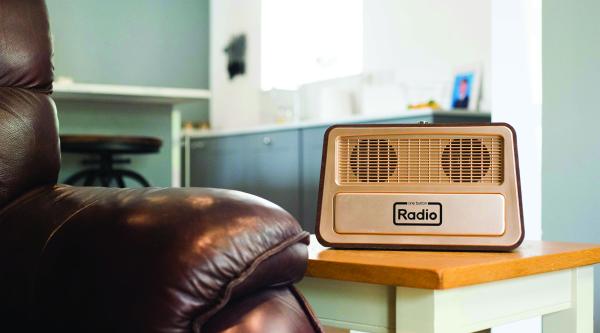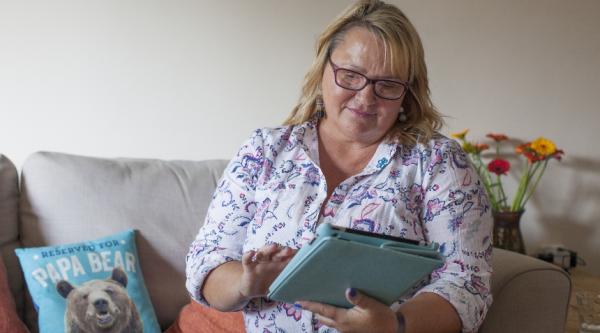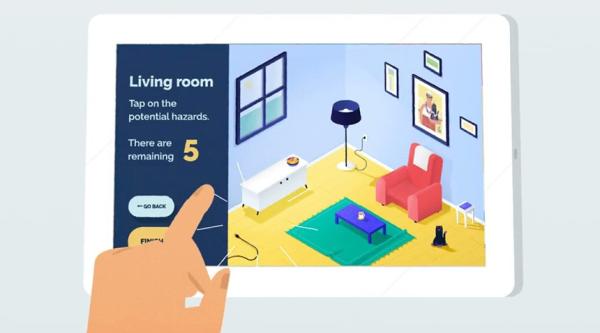What equipment can improve the home of a person with dementia?
Homes can be adapted to make daily life easier for people living with dementia and their carers. This includes using different types of equipment and improving the design and layout of the home.
- You are here: What equipment can improve the home of a person with dementia?
- Equipment to improve the home: where to buy it and when is it free?
- Are there grants to help a person with dementia get equipment?
- Equipment to improve the home – useful organisations
Using equipment and making adaptations at home
As a person’s dementia progresses, they may find everyday tasks harder without the support of other people. For example:
- they might forget where an item is usually kept
- they might try to use objects or tools in the wrong way
- they may forget how to complete certain activities, like making a cup of tea or getting dressed.
This can make living in their own home more challenging.
However, changes can be made to a person’s home to make it easier, safer and more comfortable. This can help them go about their daily routine with less assistance for as long as possible.
How can equipment help people with dementia?
Equipment doesn’t have to be expensive or complicated to be helpful. Even small, everyday items have been found to make a positive difference to people with dementia living in their own homes.
For example, products designed to help older people live well can also be very useful for people with dementia. These include mobility aids and equipment for maintaining continence. There are also many products designed specifically to address the needs of people with dementia, such as memory aids.
It is usually a good idea for the person to start using any new equipment as early as possible, so that they can get used to it being part of their daily routine.
Assistive technology
Electronic items that are designed to help people with cognitive or memory problems are classed as ‘assistive technology’. These can help people with dementia remain active, independent and safe.
How can the layout of the home be improved for people with dementia?
As well as using equipment, making changes to the layout of areas around the home can be helpful for people with dementia. This includes:
- rearranging furniture and fittings in a way that makes them easy to access and use
- installing wide doors for wheelchairs or specially designed shower and toilet facilities
- keeping surfaces and floors clear and uncluttered to reduce confusion and help prevent trips and falls
- putting signs on doors and cupboards to make it easier for the person to find their way around the home
- having good lighting can help keep the person safe (for example, lights that come on automatically may help prevent falls if the person gets out of bed and walks about at night)
- draughtproofing and using more efficient heating.
How can the design of a home be improved for people with dementia?
Problematic patterns and surfaces
Certain patterns and surfaces cause problems for some people with dementia, who find it hard to understand what they are seeing. For example:
- patterned carpets can be mistaken for uneven ground
- dark mats can be confused for holes in the floor
- shiny surfaces and mirrors can also be confusing as someone may not realise that what they are seeing is a reflection
Removing these types of surfaces and patterns will help to make the home safer and easier to get around for someone with dementia.
Helpful contrasting colours
Marking out the edges of steps can be helpful for people with dementia. In the same way, using contrasting colours makes items around the house easier to locate, identify and use. This could include:
- toilet seats in a colour that contrasts with the toilet bowl and the floor
- light switches in a different colour to the wall
- handrails, taps and towels that contrast with the rest of the bathroom
- handles on doors, cupboards and drawers in a colour which stands out
- cutlery, crockery and tablecloths in a different colour to the table and the food.
How can outside space be improved for people with dementia?
Enjoying fresh air and spending time outside can improve the wellbeing of people with dementia. Gardens can help a person to do this in a safe and familiar environment.
In this way, gardens can help to contribute to a better quality of life for some people with dementia. However, the design and layout of gardens can affect how suitable they are for people with dementia.
Ways of improving them include:
- making the garden easier to get around by using a path which is free of obstacles and uneven surfaces
- installing ramps and handrails to help the person move around the garden
- putting in a raised flower or vegetable bed if a person has difficulty reaching down to work in the garden
- having sturdy garden chairs for the person to sit and look around the garden
All garden furniture, such as chairs and tables, will be easier to see and identify if it’s a different colour to its surroundings.
To help make the seating area more relaxing for people with dementia, garden ornaments and colourful plants could be set up and planted nearby. Wind chimes and small water features can also have a calming effect for a person with dementia.
What to consider when adapting the home for people with dementia
- Not everything included in this page will be of use to everyone, but it can help to know what is available.
- Decisions about equipment and layout should be made with the consent of the person with dementia where possible, especially if the changes might restrict their freedom.
- Any changes must be based on the person’s individual circumstances and needs and must be made with their best interests in mind.
- Everyone with dementia experiences the condition differently, and what may be useful for one person may not be appropriate for another.
- As dementia progresses, the support that the person needs will change. They may need to be reminded how certain equipment works or become unable to use it.
- Equipment will not be the answer to every problem, and there may be times when changing the way that something is done works better for the person with dementia. For example, someone who has difficulties sitting in the bath may find it easier to have a shower in a standing position with appropriate support.
- A piece of equipment may help the person to be safer and more independent, but they may still need assistance.
- If adaptations are made to the home, these should also be regularly reviewed to ensure that they remain helpful.
- Think about who will be paying for adaptations and improvements – and what might be available for free. The extent of the work will usually determine who will cover the cost.










There are a range of memory aids to help people remember important things.
Specially designed kitchen equipment is available. This aims to make cooking easier and safer for people who have difficulties with movement and co-ordination. This includes:
Other household tasks involve standing up for periods of time. To help make this more comfortable, people with dementia could use perching tools. These are special seats that allow people to sit while performing tasks like ironing and cleaning.
If the person forgets the order of certain tasks, a whiteboard, photographs or notes that show the steps needed for each task can also be useful.
There are many devices that can make the bathroom safer and easier to use. These include:
Sometimes, it is not possible to adapt an existing bath. In these cases, a walk-in bath, shower or wet room can also be fitted.
There is equipment that can make going to the toilet easier. There are also tools that can help with incontinence. These include:
There are lots of different types of equipment to help people keep mobile and independent. These include:
Dementia may affect a person’s co-ordination or swallowing and, as a result, their ability to eat and drink. The person may benefit from equipment such as:
Some people with dementia may have difficulties eating and drinking due to visual problems, such as not ‘seeing’ items on the table because they are a similar colour to the tablecloth.
Use cutlery, crockery and other tableware items in colours that contrast with each other. The colour of the food can also have an effect – for instance light-coloured foods (such as mashed potatoes) on a light-coloured plate may not be very visible. A dark red plate could help in this situation.